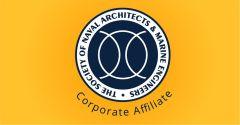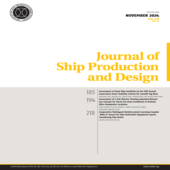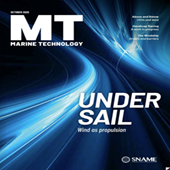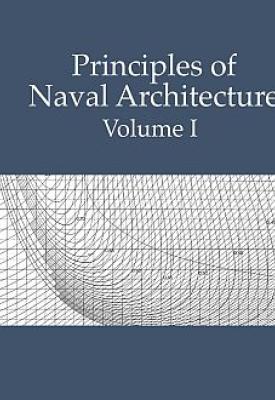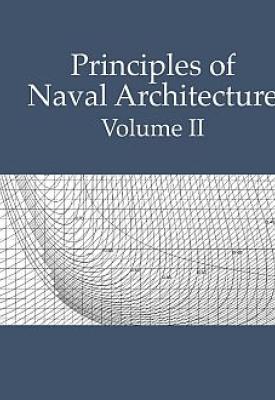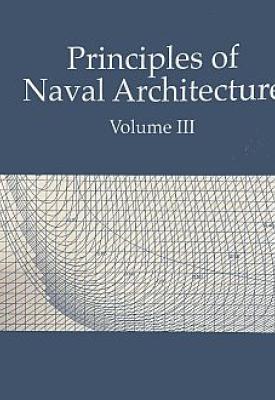PNA VOLUME I, II & III (1988)
Volume I
by Edward V. Lewis, Editor
The Society's premier reference work, a revision of the 1967 publication on naval architecture covering ship's stability and strength. A must-have reference for anyone involved in naval architecture.
ISBN: 0-939773-00-7
Soft Cover ♦ 2.5 lbs
List: $125.00
Members: $110.00
Student Members: $70.00
Volume II
by Edward V. Lewis, Editor
The Society's premier reference work, a revision of the 1967 publication on naval architecture covering Resistance, Propulsion and Vibration. A must-have reference for anyone involved in naval architecture.
ISBN: 0-939773-01-5
Soft Cover ♦ 2.5 lbs
List: $140.00
Members: $110.00
Student Members: 70.00
Volume III
by Edward V. Lewis, Editor
The Society's premier reference work, a revision of the 1967 publication on naval architecture covering ship's motion in waves. A must-have reference for anyone involved in naval architecture.
ISBN: 0-939773-02-3
Soft Cover ♦ 2.5 lbs
List: $140.00
Members: $110.00
Student Members: $70.00
PNA THREE-VOLUME SET
PNA INDIVIDUAL CHAPTERS, UPDATED 2008 - 2010
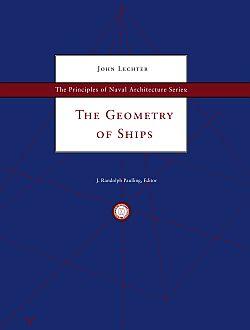
ISBN: 0-939773-67-1
58 pages ♦ Soft Cover ♦ 1 lb
List Price: $90.00
Member Price: $70.00
Student Member Price: $50.00
PRINCIPLES OF NAVAL ARCHITECTURE SERIES:
THE GEOMETRY OF SHIPS
by John Letcher, Edited by J. Randolph Paulling (2009)
Although there are still practitioners of the traditional art of manual fairing of ship lines, the geometry of most hull forms ranging from small yachts to the largest commercial and naval ships are now almost invariably developed using one of the commercially available hull modeling software packages. Such software normally includes, in addition to the hull modeling and display functions, routines for the computation of hydrostatics, stability and other hull properties. It may form a part of a comprehensive computer-based design and manufacturing system or it may be included in a shipboard computer-based operational system used for cargo load monitoring and damage control. The present volume presents first, the theoretical basis for these hull modeling systems and second, the procedures for computing hull geometric, buoyancy and other properties by mathematical methods utilizing such models. The emphasis is upon the nomenclature and fundamentals underlying several different methods of hull geometrical modeling with the intention of providing the understanding needed to use intelligently both existing and future tools. Some topics included in the volume are continuity and fairness of surfaces, B-spline and NURBS representation, ruled and developable surfaces, subdivision surfaces, and classic computational topics such as hydrostatic properties and initial stability. This is a subject area characterized by a continuing stream of innovation and new software products so the objective here is to present the basis needed to understand and keep abreast of new developments in the field. * Replaces Chapter 1 in PNA Volume I: Stability and Strength |

ISBN: 978-0-939773-74-9
82 pages ♦ Soft Cover ♦ 2 lbs
List Price: $60.00
Member Price: $40.00
Student Member Price: $30.00
PRINCIPLES OF NAVAL ARCHITECTURE SERIES:
INTACT STABILITY
by Colin S. Moore, Edited by J. Randolph Paulling (2010)
Written by Dr. Colin S. Moore, Manager, Advanced Analysis and Salvage Engineering at Herbert Engineering Corp. and a member of SNAME ad hoc committees on Double Hull Intact Stability and Parametric Rolling, the new volume in the PNA series discusses various effects on stability, such as changes in hull geometry, changes in weight distribution, suspended weights, partial support due to grounding or drydocking and free liquid surfaces in tanks or other internal spaces.
The concept of dynamic stability is introduced, starting from the ship’s response to an impulsive heeling moment. The effects of waves on resistance to capsize are discussed noting that, in some cases, the wave effect may result in diminished stability and dangerous dynamic effects.
*Replaces Chapter 2 in PNA Volume I: Stability and Strength
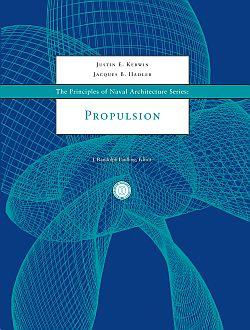
ISBN: 978-0-939773-83-1
208 Pages ♦ Soft Cover ♦ 2 lbs
List Price: $90.00
Member Price: $70.00
Student Member Price: $50.00
PRINCIPLES OF NAVAL ARCHITECTURE SERIES:
PROPULSION
by Justin E. Kerwin and Jacques B. Hadler, Edited by J. Randolph Paulling (2010)
This book presents a comprehensive and up-to-date treatment of propeller analysis and design, including beginning with an introduction to various types of marine propulsion machinery, definitions of powers and efficiencies, and two- and three-dimensional airfoil theory. A section on three-dimensional hydrofoil theory introduces wake vortex sheets and three-dimensional vortex lines. These discussions topics are followed by linear lifting line- and lifting surface theory with both exact and approximate solution methods—including properties of helicoidal vortex sheets, optimum and arbitrary circulation distributions, and the Lerbs induction factor method. There are sections on model testing of propellers, propeller strength and followed by selection and design using both standard series charts and by circulation theory. The final section discusses ship standardization trials, their purpose, measurement methods and instruments, concluding with the analysis of trial data and derivation of the model-ship correlation allowance.
*Replaces Chapter 6 in PNA Volume II: Resistance, Propulsion, and Vibration
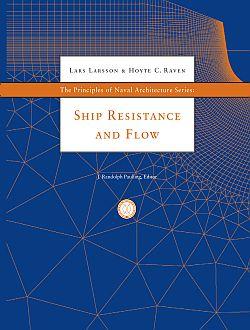
ISBN 978-0-939773-76-3
223 pages ♦ Soft Cover ♦ 1 lb
List Price: $90.00
Member Price: $70.00
Student Member Price: $50.00
PRINCIPLES OF NAVAL ARCHITECTURE:
SHIP RESISTANCE & FLOW
by Lars Larsson & Hoyte C. Raven, Edited by J. Randolph Paulling (2010)
The Principles of Naval Architecture series is the defining reference work and text for naval architecture. This volume contains a completely new presentation of the subject of ship resistance embodying these developments. A major goal in the design of virtually all vessels is to obtain a hull form having low resistance. In achieving this goal, the accurate prediction of resistance for a given hull geometry is essential. Since the publication of the previous edition of PNA important advances have been made in theoretical and computational fluid dynamics accompanied by increased use of such work in ship and offshore structure design.
The first section of the book provides basic understanding of the flow phenomena that underlie the resistance encountered by a ship moving in water. The second section contains an introduction to the methods by which that knowledge is applied to the prediction of resistance, including model testing, empirical methods and computational methods. A final section provides guidance to the naval architect in designing a hull form. Design procedures are described for achieving favorable flow and resistance characteristics of the hull and appendages. Examples are given for ships designed for high, medium and low speeds. Design considerations affecting both wave and viscous effects are included. Finally the flow in the stern wake is discussed, an area important for both resistance and propeller performance.
*Replaces Chapter 4 in PNA Volume II: Resistance, Propulsion, and Vibration
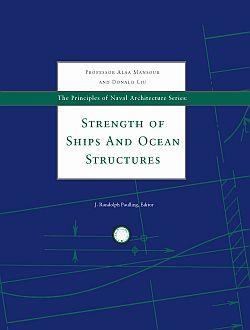
ISBN: ISBN 0-939773-66-x
226 pages ♦ Soft Cover ♦ 2 lbs
List Price: $90.00
Member Price: $70.00
Student Member Price: $50.00
PRINCIPLES OF NAVAL ARCHITECTURE SERIES:
STRENGTH OF SHIPS AND OCEAN STRUCTURES
by Alaa Mansour and Don Liu, Edited by J. Randolph Paulling (2008)
This new revised volume on Strength of Ships and Ocean Structures addresses several topics of ship strength in greater depth than in the previous edition of PNA, bringing much of the material up to date and introducing some new subjects. There is extensive coverage of the latest developments in dynamic sea load predictions, including nonlinear load effects, slamming and impact plus new sections on the mechanics of collisions and grounding. The incorporation of the various loadings in structural design and analysis is covered including long term extreme and cumulative fatigue effects. There is a more extensive treatment of strength analysis using finite element methods than was included in the previous edition. Ultimate strength evaluation of the hull girder and components is covered and there is a section on structural safety assessment applying reliability concepts including fatigue effects. Particular attention is given to problems encountered in ships of special type and size that have been developed in recent years, many of which, by reason of size, configuration or lack of a history of design experience, require a design approach based on first principles. Modern developments in classification society strength standards and modern rule developments are covered including Common Structural Rules for tankers and bulk carriers. The concluding sections discuss materials other than steel, including composites and aluminum, and vessels of unusual geometry and performance such as multihulls, hydrofoils, and SWATH craft.
*Replaces Chapter 4 in PNA Volume I: Stability and Strength
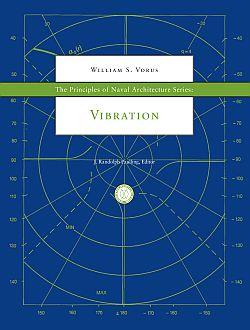
ISBN: ISBN 978-0-939773-75-6
62 pages ♦ Soft Cover ♦ 1 lb
List Price: $60.00
Member Price: $40.00
Student Member Price: $35.00
PRINCIPLES OF NAVAL ARCHITECTURE SERIES:
VIBRATION
by William S. Vorus, Edited by J. Randolph Paulling (2010)
Principles of Naval Architecture series is the defining reference work and text for naval architecture. This volume presents the principles underlying analysis of the vibration characteristics of modern seagoing ships and the application of those principles in design and problem solving.
The classical continuous beam model with steady state response to periodic excitation is presented first. This includes natural frequencies, mode shapes and modal expansion. Discrete analysis is next presented based upon finite element principles. Examples are discussed involving analysis of the entire ship and component parts, e.g., the deckhouse. There are sections on vibration surveys, sea trials, acceptable vibration standards and criteria. Concluding sections treat methods of remediation of vibration problems that are found after the ship is completed, including modifications to propeller design, structure and machinery.
*Replaces Chapter 7 in PNA Volume II: Resistance, Propulsion, and Vibration
PNA series, Eight-chapter set
The Principles of Naval Architecture series is the defining reference work and text for naval architecture.
Purchase all 6 chapters in the series and receive a 30% discount!
List: $595.00
Members: $445.00
Student Members: $325.00
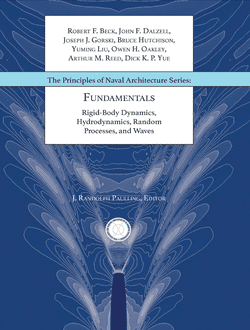
ISBN: 978-1-7923-1233-5
238 pages ♦ Soft Cover ♦ 3 lb
List Price: $140.00
Member Price: $115.00
Student Member Price: $70.00
PRINCIPLES OF NAVAL ARCHITECTURE SERIES:
FUNDAMENTALS: RIGID-BODY DYNAMICS, HYDRODYNAMICS, RANDOM PROCESSES, AND WAVES
by Robert F. Beck, John F. Dalzell, Joseph J. Gorski, Bruce Hutchison, Yuming Liu, Owen H. Oakley, Arthur M. Reed, Dick K.P. Yue Edited by J. Randolph Paulling (2024)
The estimation of hydrodynamic loads and the stochastic nature of ocean wave excitation are fundamental issues that set naval architecture and ocean engineering apart from much of civil engineering. In this new edition of PNA, the presentation attempts to introduce the key topics that all those involved with ocean related engineering should be somewhat familiar with. The presentation also attempts to provide a bridge to more advanced theories and recent developments. This edition significantly expands and supersedes many aspects discussed in the previous version of PNA. The presentation begins by addressing the fundamental approaches to modeling the motions of a ship or offshore platform. These include coordinate systems and transformations, rigid-body equations of motion, the Navier-Stokes equations governing fluid motion, and approaches to their solution. This is followed by a presentation of topics from random process theory that tackles the inescapable problem of the stochastic nature of the ocean and associated parameters of interest. The chapter provides a careful and expansive development of random process theory as applied to marine dynamic responses to waves. The presentation goes beyond the previous editions with expanded and new sections addressing joint responses; uncertainties associated with time-domain samples; quadratic nonlinearities in random processes; and the problem of rarity.
Finally, chapters on gravity waves and ocean waves go into detail addressing the basic physics of surface gravity waves and the modeling of the ocean environment. New topics include advanced tools for forecasting and hindcasting of sea states with nonlinear theories and numerical phase-resolved simulations.
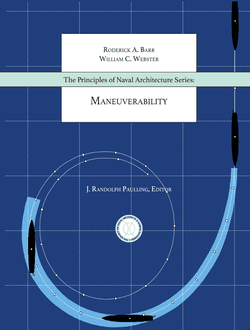
ISBN: 978-1-7923-1234-2
247 pages ♦ Soft Cover ♦ 3 lb
List Price: $120.00
Member Price: $100.00
Student Member Price: $60.00
PRINCIPLES OF NAVAL ARCHITECTURE SERIES: MANEUVERABILITY
Roderick A. Barr and William C. Webster by J. Randolph Paulling (2024)
This volume represents a significant departure from the Controllability Chapters of previous editions of the Principles of Naval Architecture in philosophy, in content and in name. The volume name Maneuver-ability is felt to reflect the intent of the chapter more adequately than does the title of the chapter in previous editions. The primary goal of previous chapters has been to provide information needed by designers to estimate the maneuvering performance and controllability of a ship based primarily on principal characteristics. With increasing ship sizes and concerns for ship and environmental safety, the accuracy of such estimates is now adequate only for earlier stages of ship design. Such methods can rarely provide sufficient accuracy for meaningful studies of critical maneuvering problems such as transit of restricted waterways and harbors. Such studies are now almost always carried out by organizations which specialize in maneuvering performance. A primary goal of this new volume is therefore to provide the designer with both the information and tools needed to design ships which can be reasonably expected to have satisfactory maneuverability and controllability, and to provide the knowledge needed to make cost-effective use of organizations specializing in maneuvering performance. To this end, this volume provides a more detailed introduction to the basics of maneuvering and a more detailed discussion of simulation and simulators than did previous editions. This volume also provides an expanded discussion of maneuverability and controllability of submarines and submersibles.
* Replaces the Controllability chapter in PNA Volume III: 1989 Version



